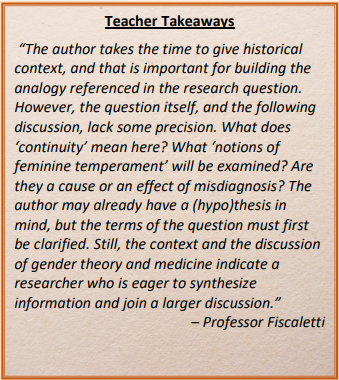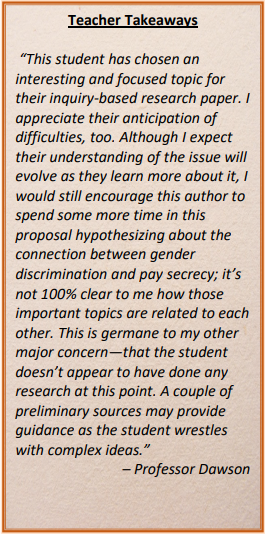5.2.4: Model Texts by Student Authors
- Last updated
- Save as PDF
- Page ID
- 109855
Model Texts by Student Authors
Pirates & Anarchy104
(Research proposal- see the annotated bibliography here and final essay here)
My inquiry has to do with piracy and its relationship with anarchist culture. There seem to be two tipping points to the life cycles of piratical and anarchist cultures. First, there is the societal inequality and/or economic stagnation that cause groups to lose faith in established power structures (Samatar 1377). This disenfranchisement leads to groups' choosing to take self-guided action, to meet needs not satisfied. It is a bid for freedom. The other shift appears to be when the actions of the group become predatory upon vulnerable groups. What begins as notions of self-sufficiency become violent victimizations of other segments of society (Wilson ix).
The current guiding questions that I am following are these: What societal breakdowns lead to groups subscribing to anarchist philosophies? Are pirates and anarchists synonymous? Do the successes and/or failures of pirate organizations create any lasting change in the societies from which they spring?
Piracy has been around for a very long time and has taken on many forms. one of these incarnations was the seafaring sort terrorizing ships during the golden age of piracy in the seventeenth century. Another example was the Somali pirates preying on the African coast in the early 2000s. Information pirates in cyberspace and anarchist protestors in political activism are current forms. The relevance of why individuals turn to piracy is important to explore.
Political polarization continues to freeze up the government, rendering them ineffectual. Worse, elected officials appear more concerned with ideology and campaign funding than the plight of the common man, leaving their own constituents' needs abandoned. Citizens may turn to extreme political philosophies such as anarchy as a way to take piratical action to counteract economic disparity. A pervasive sense of powerlessness and underrepresentation may lead to the splintering of societal structure, even rebellion. Of import is understanding whether acts of piracy lead to societal erosion via this loss of faith and turn to violence, shrugging off accountability to the system as a countermeasure to what is seen as government's inability to provide a free and fair system. This may be seen as empowering. It may also signal a breakdown of centralized government.
There are several difficulties I anticipate. Dedicating time in an efficient manner is the main concern with managing this project. This topic will require a lot of exploration in research. At the same time, writing and revising need their fair share of dedication. I'm looking to find that balance so each aspect of the process gets its due. I will handle this by utilizing the strategy of setting a timer for research and then for writing. A little of both will get done each day, with greater allotments of time given to writing as I go along.
Also of concern is narrowing this topic further. The phenomenon of piracy is so interesting to me, especially in the context of history. However, considering how this topic may be relevant in the current shifting political landscape, it seems important to dwell on the now as well as the past. Much has been written already on piracy, so I'll be going into my research looking for a more focused place where I can contribute to the subject matter. I'm going to st up a couple of writing center appointments to get some guidance as I go along.
Finally, I want to be watchful of wandering. Many side paths are open to inspection with this topic. Not only will this waste time, but it will also weaken my argument. Once I tighten up the thesis, I want to make sure my research and writing stay focused.
Works Cited
Samatar, Abdi Ismail, Lindberg, Mark, and Mahayni, Basil. “The Dialectics of Piracy in Somalia: The Rich Versus the Poor.” Third World Quarterly, vol. 31, no. 8, 2010, pp. 1377-1394. EBSCOhost, doi:10.1080/01436597.2010.538238.
Wilson, Peter Lamborn. Preface. The Devil’s Anarchy: The Sea Robberies of the Most Famous Pirate Claes G. Compaen and The Very Remarkable Travels of Jan Erasmus Reyning, Buccaneer by Stephen Snelders, Autonomedia, 2005, pp. viixi.

A Case of Hysterics105
(Research proposal- see the annotated bibliography here and final essay here)
The concept of female Hysteria was a medical recognition dating back to the 13th century that had been diagnosed by physicians quite liberally until recent times. The diagnosis and treatment of Hysteria were routine for hundreds of years in Western Europe, as well as the United States. Symptoms that indicated Hysteria were broad and all encompassing: nervousness, sexual desire, faintness, insomnia, irritability, loss of appetite, depression, heaviness in abdomen, etc. These symptoms were said to be caused by a "wandering womb," described as a kind of living creature that sought to disrupt biological processes, disrupt breathing, and cause disease.
The number of diagnosed cases of hysteria slowed as medical achievements proceeded, and in the early 1960s (coinciding with the popularization of feminism) the "disease" ceased to be considered a true medical disorder. In modern medicine, however, the treatment and diagnosis of female medical issues continues to be vague and potentially harmful due to lack of knowledge. Does the concept of female hysteria have continuity today?
Although the vocabulary has changed, it is clear that the practice of ignoring serious medical ailments based on sex remains prominent in the world of medicine. It is not uncommon for a physician to diagnose a woman with chronic stress or psychosomatic issues, and then later discover a disease like lupus, fibromyalgia, or polycystic ovarian syndrome, all of which are still commonly dismissed because it is likely the patient is experiencing the chronic pain in their heads. Because of sexism in the medical field, many woman are receiving subpar healthcare. In my research, I will examine the past culture of Hysteria as well as the current state of misdiagnoses of women's health issues and how this reinforces gender norms in today's society; this will demonstrate the need for eliminating bias and sexism in medicine.
In my research process, I imagine I will encounter difficulties in finding detailed scientific research in the misdiagnoses of women's health, despite having found multiple accounts on non-scientific platforms. I also anticipate a possible attitude of mistrust coming from the audience because of this topic; it is common nature to trust doctors blindly, as well as the norm in our culture to assume women are irrational and excessive. Finally, it will be difficult to attribute sexism and bias simply to the idea of misidentification of ailments. While this is common, sexism has also contributed to, plainly, a lack of research and knowledge of female healthcare. Therefore, willful ignorance plays a role in the imbalance between male and female medicine as well. I will mention this concept briefly in my essay, but continue to focus on the idea of frequent female misdiagnosis and how this perpetuates preconceived notions of feminine temperament in society.

Wage Transparency and the Gender Divide106
Discussing salaries with neighbors and especially colleagues is often an unthinkable offense against social mores in the United States. Pay secrecy has long been the norm in most of Western society, but it comes with an information imbalance during any salary negotiations. Lately, wage transparency has gained some legal foothold at the national level as a tool to combat gender wage disparity for equal work. Is pay transparency an effective tool to close the gender pay gap, or will it only succeed in making colleagues uncomfortable?
States have been successively passing local laws to reinforce prior national legislation protecting employees' rights to share salary information, and recent hacks have made information public involuntarily. In some situations, like in Norway, wage transparent has been the law for years. Norway also has the third smallest wage gap in the world. Compensation also has an impact on self-esteem and performance, so the wage gap could be causing a systematic decrease in self-worth for women in the workforce relative to their male counterparts. I plan to research whether increased wage transparency would cause a decrease in the gender pay gap.
There are readily available statistics on the wage gap, although it may be difficult to avoid politically polarized sources. I'm not sure how available analytical studies of pay transparency will be, although sites like Glassdoor have published some admittedly self-serving studies. It will be difficult, although interesting, to assess the issue of pay transparency and the wage gap, as they are both complex sociological issues.



